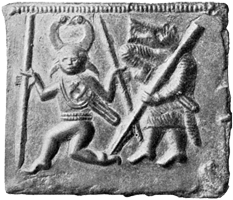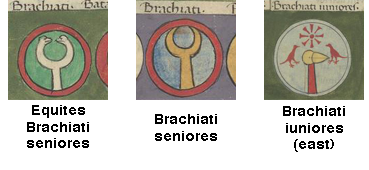
This page created 1 May 2014, and last modified: 26 October 2014 (Frankfurt fragment picture added)

In the western half of the empire, the second-most senior of all the auxilia palatina units is the Brachiati seniores, in the Magister Peditum's Italian command. Its shield pattern, as shown in various manuscripts under the plain label Brachiati, is as below:

The shield pattern has a blue ground with a red rim, and a yellow figure (more orange in B) that appears to be a debased version of the twin-headed zoomorphic motif that is extremely common in the Notitia (over a dozen examples), especially amongst auxilia palatina: the version borne by the Brachiati seniores lacks the "heads" (as do those of the adjacent auxilia palatina units in the illustrations, the Cornuti seniores and the Petulantes seniores); however the Froben edition ("B") has some indication of the heads as the tips of the right horn of the pattern is somewhat bulbous.
In addition to its numerous appearances in the Notitia, the twin-headed zoomorphic motif is known from a range of sources in northern Europe, such as on the ca. 6th century Torslunda bronze die from Sweden shown below:

The name Brachiati (Bracchiati is often found outside the Notitia) is usually taken to refer to upper arm bracelets (bracchia), or trousers (brachae), and is shared with five other units in the Notitia: in the west, the Equites Brachiati seniores, one of the vexillationes palatinae listed the Magister Equitum's cavalry roster and assigned to the Magister Peditum's Italian command; the Equites Brachiati iuniores, one of the vexillationes palatinae under the Magister Militum Praesentalis II in the eastern half of the empire; in the west, another unit called the Equites Brachiati iuniores, and assigned to the Magister Equitum's Gallic command but missing from his cavalry list (where it was rather arbitrarily interpolated by Seeck); in the east, the Brachiati iuniores, a unit of auxilia palatina under the command of the Magister Militum Praesentalis I; and in the west, another unit of auxilia palatina called the Brachiati iuniores, in the Magister Equitum's Gallic command, which may well correspond to the plain Brachiati listed in the Magister Peditum's infantry roster. The shield patterns for both of the Equites Brachiati iuniores as well as the western infantry Brachiati (iuniores) are not recorded; those of the other three units are given below, using the pictures taken from the Parisian manuscript, P:

The Equites Brachiati seniores is the only unit of cavalry in the Notitia to bear such a twin-headed zoomorphic pattern. This may not be as significant as it might sound, given how few cavalry units have their patterns recorded; further the Equites Mauri alites bears a variant of the device, in which the two heads are not conjoined.
In Ammianus's history, "the" Brachiati are brigaded with the Cornuti (15.5.30); the two were famous for their rendition of the "barritus", or war-cry (Ammianus 16.12.43). In the Notitia, immediately before the Brachiati seniores is indeed the Cornuti seniores, whereas in the east, the Brachiati iuniores appears after the (eastern) Batavi seniores. Thus the Brachiati at the Battle of Strasbourg in 357 were likely the western Brachiati seniores and not the eastern seniores or the western Brachiati iuniores units.
Inscriptional evidence for the Brachiati seniores comes from the cemetery at Colonia Iulia Concordia (modern Portogruaro in Veneto, Italy), which produced an inscription (CIL 5, 8740 = ILS 2798; photo here) mentioning a unit in the form of the NVMERI BRACCHIATORVM. This probably refers to the Brachiati seniores, given the Italian location of the cemetery, and the assignment of the (western) Brachiati iuniores to Gaul, unlike the Italian assignment of the Brachiati seniores; however, note the Equites Brachiati seniores is also assigned to the Italian command (it is, however, separately recorded at Concordia in the form N BRAC SEN EQUIT). See here for Hoffmann's 1963 analysis (in German).

Return to the Notitia alphabetical unit list page.
Return to my Notitia index page.